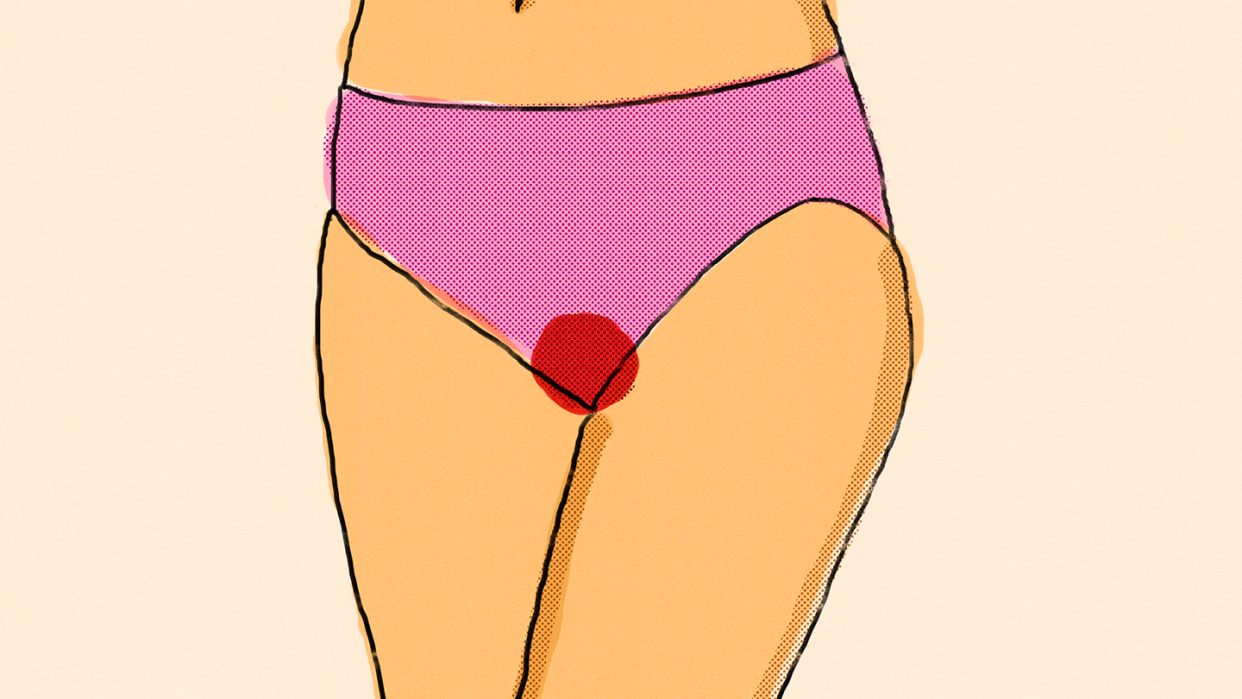8 Period Red Flags You Should Never Ignore

- Oops!Something went wrong.Please try again later.
"Hearst Magazines and Yahoo may earn commission or revenue on some items through these links."
Your period speaks to you, and it says more than "bring me fries dipped in ice cream, NOW." Here's what to look out for — and when to call your ob/gyn:
1. You're Experiencing Very Heavy Bleeding
Heavy bleeding can be cause for concern, saysRachel Carlton Abrams, M.D., a board-certified physician and author of BodyWise: Discovering Your Body's Intelligence for Lifelong Health and Healing. "[It] can be a sign of fibroids (benign tumors in the uterus), hormonal imbalance (typically an abundance of estrogen and not enough progesterone), stress (which reduces progesterone), [or] thyroid dysfunction (typically hypothyroidism). If you've always had very heavy bleeding, it could be a sign of a clotting disorder."
When everything is running smoothly, you're probably going through anywhere from 3-6 tampons a day — "[a] normal amount of blood is 4-12 teaspoons each cycle," saysDr. Sherry, A. Ross, M.D., a women's health expert and author ofShe-ology: The Definitive Guide to Women's Intimate Health. Period. "If your period lasts longer than seven days and you're changing tampons or pads more than every two hours each day, then this is a sign of a heavier than average flow," says women's health and functional nutrition coach Nicole Jardim. Needing both a pad and tampon to control your flow or having to change pads or tampons during the night are more red flags, she says.
2. You Have Super Painful Cramps
Don't write them off as par for the course. "Extremely painful cramps can be an indicator of endometriosis, where the cells that line the uterus travel through the fallopian tubes and out into the pelvis," says Dr. Abrams. "When the uterus sheds its lining, the misplaced cells bleed into the pelvic cavity, causing pain." So how can you tell whether your cramps are normal? "Pain is very much subjective; however, pain that is lifestyle-altering or interfering with your ability to do your routine activities is never normal," explainsDr. Angela Jones, M.D., the ob/gyn behind the Ask Dr. Angela podcast. If the pain doesn't ease up with non-steroidal anti-inflammatory drugs (NSAIDS) like aspirin and ibuprofen and heating pads, talk to your doctor, she says.
3. You Missed Your Period
Though it's tempting to celebrate a week off from cramps, your ugliest underwear, and the overwhelming desire to eat cake frosting with your hands, a missing period could be a warning sign. "Lack of a period can happen because of stress, hormonal changes, menopause, low body fat (from too few calories or over-exercising), or, of course, pregnancy," says Dr. Abrams. "It can also happen with an over-functioning thyroid gland (hyperthyroidism). And, rarely, it can be a sign of tumors in the ovaries, pituitary gland, or hypothalamus."
4. You've Always Had Long Cycles and Irregularity
"Periods that have always been a bit irregular with typically long cycles (sometimes with months between) can be a sign of a hormonal imbalance called Polycystic Ovarian Syndrome," says Dr. Abrams. Other symptoms can include weight gain, fatigue, excessive hair growth on the face and body, thinning hair on the head, acne, headaches, sleep problems, pelvic pain, and mood changes,according to the PCOS Awareness Association. An endocrinologist can run blood tests and an ob/gyn can check for cysts with an ultrasound to help you figure out what's going on.
5. You Have Ongoing Spotting
Irregular bleeding that looks like a few spots of reddish brown blood at unexpected times of the cycle can be normal, Dr. Ross says. "Some women can have spotting that lasts a couple of days then stops and restarts again during the middle of the month. Brown spotting can also happen mid-cycle or during ovulating." But if brown spotting continues for more than 2-3 months, contact your doc to figure out the cause. Anything from sudden weight changes and emotional or physical stress to thyroid disorders and sexually transmitted infections can cause it, she says, so don't try to get a Google diagnosis.
6. Your Menstrual Blood Is Light Pink or Thinned Out
"Period blood that is too little, thinned out, [or] lighter in color (kind of like watermelon juice or watered down cranberry juice) can indicate your estrogen is too low to build the uterine lining properly," says Jardim. You might also experience irregular periods, vaginal dryness, low sex drive, hair loss, or hair thinning with low estrogen.
7. Your Menstrual Blood Contains Lots of Clumps
"The contents of your period commonly include a mix of blood, vaginal fluid, and uterine lining cells," explains Jardim. Seeing a few small clots on your heavier days is normal, but if you're seeing them every day of your period or they're large — anything the size of a quarter or bigger could indicate an issue, according to the Center for Disease Control and Prevention — see your doctor. Blood clots could be an indicator of endometriosis, polyps obstructing blood flow, fibroids, and more, according to Jardim.
8. Your Period Has Lasted More Than a Week
"A period lasting more than seven days would certainly raise my eyebrows," says Dr. Jones. "At that point, I would likely recommend some sort of imaging, i.e., an ultrasound, to look for an obvious source. Some of the more common causes of prolonged periods can be polyps or fibroids, both of which are typically benign."
Bottom line? Your period may not resemble a tampon commercial, but you shouldn't suffer through serious or painful symptoms month after month, either. If any of these red flags sound familiar — or if something else is going on that's got you concerned — make an appointment with your doctor.
You Might Also Like

